Enhanced Shielding Performance of Layered Carbon Fiber Composites Filled with Carbonyl Iron and Carbon Nanotubes in the Koch Curve Fractal Method
Abstract
:1. Introduction
2. Results and Discussion
- SE—Shielding effectiveness, the unit is decibel (dB).
- P0—Power received without shielding material, the unit is Watt (W).
- P1—Power received with shielding material, the unit is Watt (W).
3. Experimental Procedures
3.1. Raw Materials
3.2. Characterization
3.3. Preparation
4. Conclusions
Author Contributions
Funding
Acknowledgments
Conflicts of Interest
References
- Hu, T.; Wang, J.; Wang, J.L. Electromagnetic interference shielding properties of carbon fiber cloth based composites with different layer orientation. Mater. Lett. 2015, 158, 163–166. [Google Scholar] [CrossRef]
- Luo, X.C.; Chung, D.D.L. Electromagnetic interference shielding using continuous carbon-fiber carbon-matrix and polymer-matrix composites. Compos. Part B 1999, 30, 227–231. [Google Scholar] [CrossRef]
- Hu, T.; Wang, J.; Wang, J.L. Electromagnetic shielding properties of carbon fiber felt–glass fiber felt based multilayer composites with different layer angle. Mater. Lett. 2015, 153, 20–23. [Google Scholar] [CrossRef]
- Qu, Z.M.; Liu, S.H.; Wang, Q.G.; Wang, Y.L.; Lei, Y.S. Electromagnetic shielding properties of multilayered composites containing multiple inclusions with various spatial distributions. Mater. Lett. 2013, 109, 42–45. [Google Scholar]
- Micheli, D.; Vricella, A.; Pastore, R.; Delfini, A.; Giusti, A.; Albano, M.; Marchetti, M.; Moglie, F.; Mariani Primiani, V. Ballistic and electromagnetic shielding behaviour of multifunctional Kevlar fiber reinforced epoxy composites modified by carbon nanotubes. Carbon 2016, 104, 141–156. [Google Scholar] [CrossRef]
- Hu, T.; Wang, J.; Wang, J.L.; Chen, R.H. Electromagnetic interference shielding properties of carbonyl iron powder-carbon fiber felt/epoxy resin composites with different layer angle. Mater. Lett. 2015, 142, 242–245. [Google Scholar] [CrossRef]
- Zang, Y.J.; Xia, S.X.; Li, L.; Ren, G.Z.; Chen, Q.P.; Quan, H.Y.; Wu, Q.L. Microwave absorption enhancement of rectangular activated carbon fibers screen composites. Compos. Part B 2015, 77, 371–378. [Google Scholar] [CrossRef]
- Zhao, Z.J.; Zhang, B.Y.; Du, Y.; Hei, Y.W.; Yi, X.S.; Shi, F.H.; Xian, G.J. MWCNT modified structure-conductive composite and its electromagnetic shielding behavior. Compos. Part B 2017, 130, 21–27. [Google Scholar] [CrossRef]
- Min, Z.Y.; Yang, H.; Chen, F.; Kuang, T.R. Scale-up production of lightweight high-strength polystyrene/carbonaceous filler composite foams with high-performance electromagnetic interference shielding. Mater. Lett. 2018, 230, 157–160. [Google Scholar] [CrossRef]
- Wen, B.Y.; Wang, X.J.; Zhang, Y. Ultrathin and anisotropic polyvinyl butyral/Ni-graphite/short-cut carbon fibre film with high electromagnetic shielding performance. Compos. Sci. Technol. 2019, 169, 127–134. [Google Scholar] [CrossRef]
- Xia, S.; Yao, B.; Chen, Q.; Yu, X.H.; Wu, Q.L. Composites with Koch fractal activated carbon fiber felt screens for strong microwave absorption. Compos. Part B 2016, 107, 1–7. [Google Scholar] [CrossRef]
- Zhou, Y.Y.; Zhou, W.C.; Li, R.; Qing, Y.C.; Luo, F.; Zhu, D.M. Electroless plating preparation and electromagnetic properties of Co-coated carbonyl iron particles/polyimide composite. J. Magn. Magn. Mater. 2016, 401, 251–258. [Google Scholar] [CrossRef]
- Zhou, Y.Y.; Xie, H.; Zhou, W.C.; Ren, Z.W. Enhanced antioxidation and microwave absorbing properties of SiO2-coated flaky carbonyl iron particles. J. Magn. Magn. Mater. 2018, 446, 143–149. [Google Scholar] [CrossRef]
- Xu, Y.G.; Yan, Z.Q.; Zhang, D.Y. Microwave absorbing property of a hybrid absorbent with carbonyl ironscoating on the graphite. Appl. Surf. Sci. 2015, 356, 1032–1038. [Google Scholar] [CrossRef]
- Wang, H.Y.; Zhu, D.M.; Zhou, W.C.; Luo, F. Enhanced microwave absorbing properties and heat resistance of carbonyl iron by electroless plating Co. J. Magn. Magn. Mater. 2015, 393, 445–451. [Google Scholar] [CrossRef]
- Cao, X.G.; Ren, H.; Zhang, H.Y. Preparation and microwave shielding property of silver-coated carbonyl iron powder. J. Alloy. Compd. 2015, 631, 133–137. [Google Scholar] [CrossRef]
- Thomassin, J.M.; Jérôme, C.; Pardoen, T.; Bailly, C.; Huynen, I.; Detrembleur, C. Polymer/carbon based composites as electromagnetic interference (EMI) shielding materials. Mat. Sci. Eng. R. 2013, 74, 211–232. [Google Scholar] [CrossRef]
- Jou, W.S.; Cheng, H.Z.; Hsu, C.F. The electromagnetic shielding effectiveness of carbon nanotubes polymer composites. J. Alloy. Compd. 2007, 434, 641–645. [Google Scholar] [CrossRef]
- Jia, Y.; Li, K.Z.; Xue, L.Z.; Ren, J.J.; Jing, W.; Zhang, S.Y. Electromagnetic interference shielding effectiveness of carbon fiber reinforced multilayered (PyC–SiC)n matrix composites. Ceram. Int. 2016, 42, 986–988. [Google Scholar] [CrossRef]
- Watanabe, A.; Raj, P.M.; Wong, D.; Mullapudi, R.; Tummala, R. Multilayered Electromagnetic Interference Shielding Structures for Suppressing Magnetic Field Coupling. J. Electron. Mater. 2018, 47, 5243–5250. [Google Scholar] [CrossRef]
- Liu, L.D.; Duan, Y.P.; Ma, L.X.; Liu, S.H.; Yu, Z. Microwave absorption properties of a wave-absorbing coating employing carbonyl-iron powder and carbon black. Appl. Surf. Sci. 2010, 257, 842–846. [Google Scholar] [CrossRef]
- Sankaran, S.; Deshmukh, K.; Ahamed, B.M.; Pasha, S.K.K. Recent advances in electromagnetic interference shielding properties of metal and carbon filler reinforced flexible polymer composites: A review. Compos. Part A 2018, 114, 49–71. [Google Scholar] [CrossRef]
- Joseph, N.; Sebastian, M.T. Electromagnetic interference shielding nature of PVDF-carbony liron composites. Mater. Lett. 2013, 90, 64–67. [Google Scholar] [CrossRef]
- Singh, A.K.; Shishkin, A.; Koppel, T.; Gupta, N. A review of porous lightweight composite materials for electromagnetic interference shielding. Compos. Part B 2018, 149, 188–197. [Google Scholar] [CrossRef]
- Micheli, D.; Pastore, R.; Vricella, A.; Morles, R.B.; Marchetti, M.; Delfini, A.; Moglie, F.; Primiani, V.M. Electromagnetic characterization and shielding effectiveness of concrete composite reinforced with carbon nanotubes in the mobile phones frequency band. Mater. Sci. Eng. B 2014, 188, 119–129. [Google Scholar] [CrossRef]
- Bozzetti, M.; Pisu, L.; Sarto, M.S.; Greco, S. Shielding Performance of an Expanded Copper Foil over a Wide Frequency Range. In Proceedings of the 10th Int. Symposium on Electromagnetic Compatibility (EMC Europe 2011), York, UK, 26–30 September 2011; pp. 26–30. [Google Scholar]
- Wu, H.S.; Shen, T.; Han, Y.F.; Yang, J.T.; Yuan, Y.X. Measuring Methods for Shielding Effectiveness of Electromagnetic Shielding Materials (GJB 8820-2015); The General Reserve Department of PLA: Beijing, China, 2015. [Google Scholar]
- Micheli, D.; Pastore, R.; Vricella, A.; Delfini, A.; Marchetti, M.; Santoni, F. Electromagnetic Characterization of Materials by Vector Network Analyzer Experimental Set up. In Spectroscopic Methods for Nanomaterials Characterization; Elsevier: Rome, Italy, 2017; pp. 195–236. [Google Scholar]
- Micheli, D.; Marchetti, M.; Pastore, R.; Vricella, A.; Gradoni, G.; Moglie, F.; Primiani, V.M. Shielding effectiveness of carbon nanotube reinforced concrete composites by reverberation chamber measurements. Proc. ICEAA 2015, 7297092, 145–148. [Google Scholar]
Sample Availability: Samples of the Carbon Fiber Composites are available from the authors. |
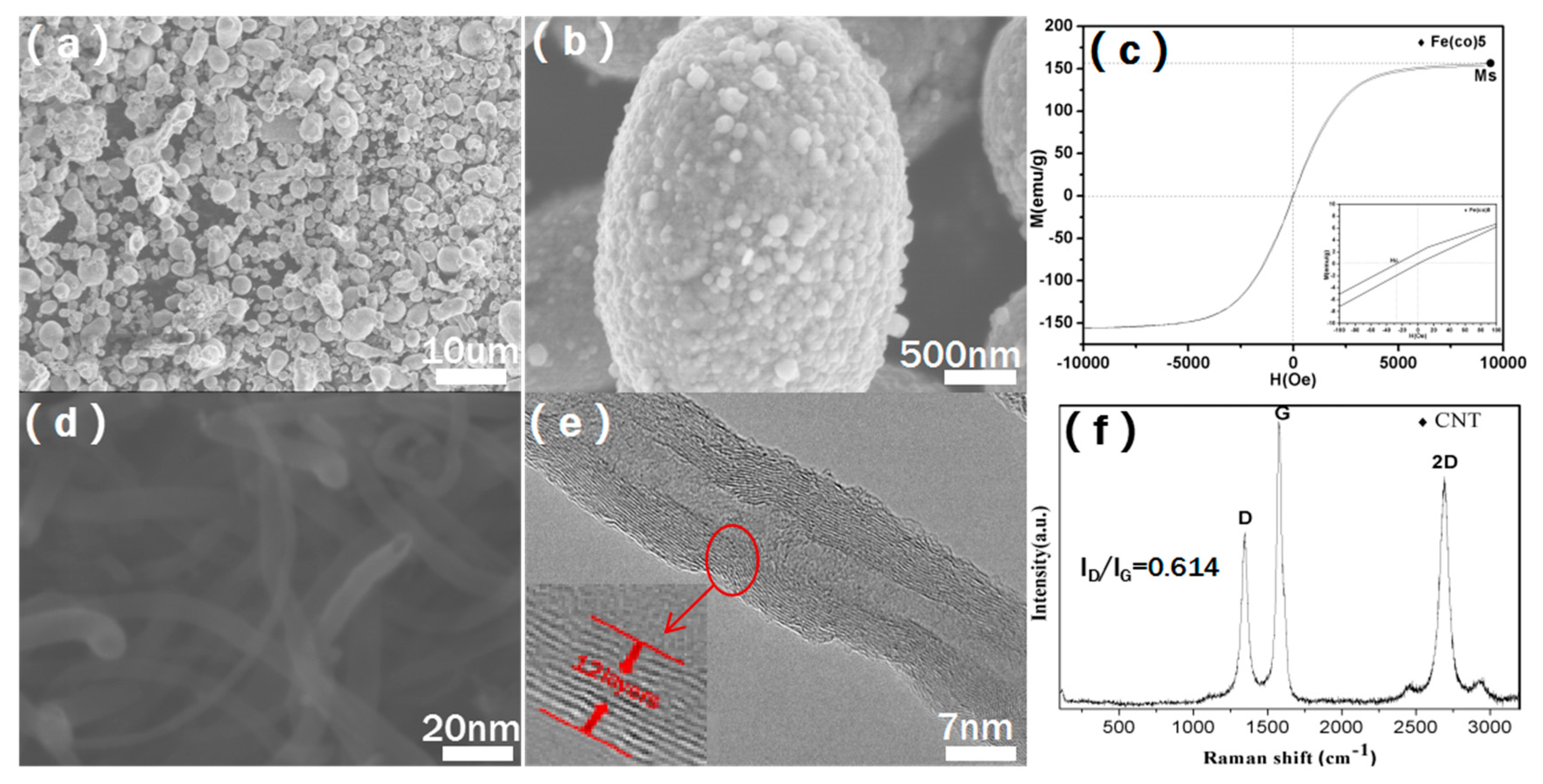
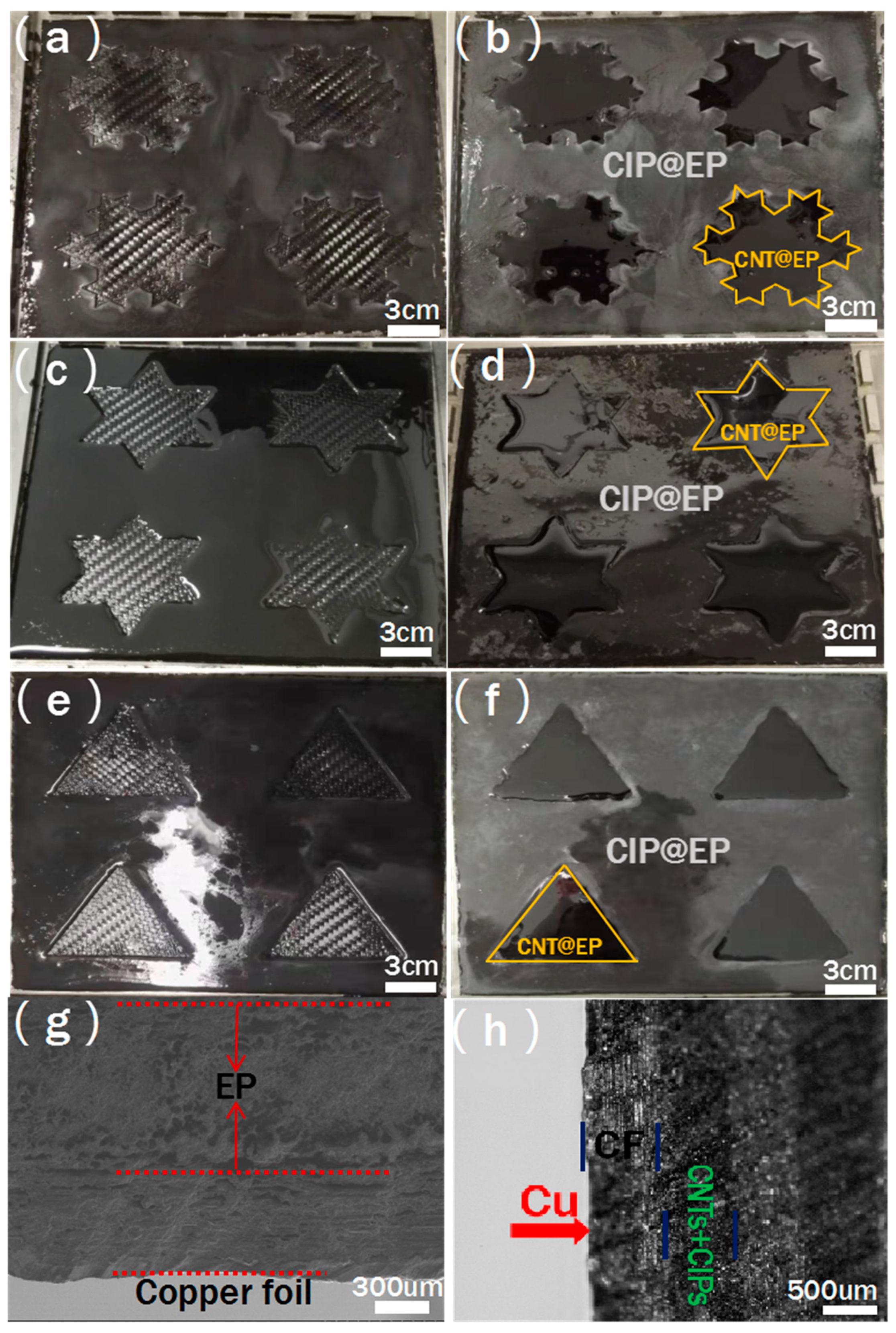
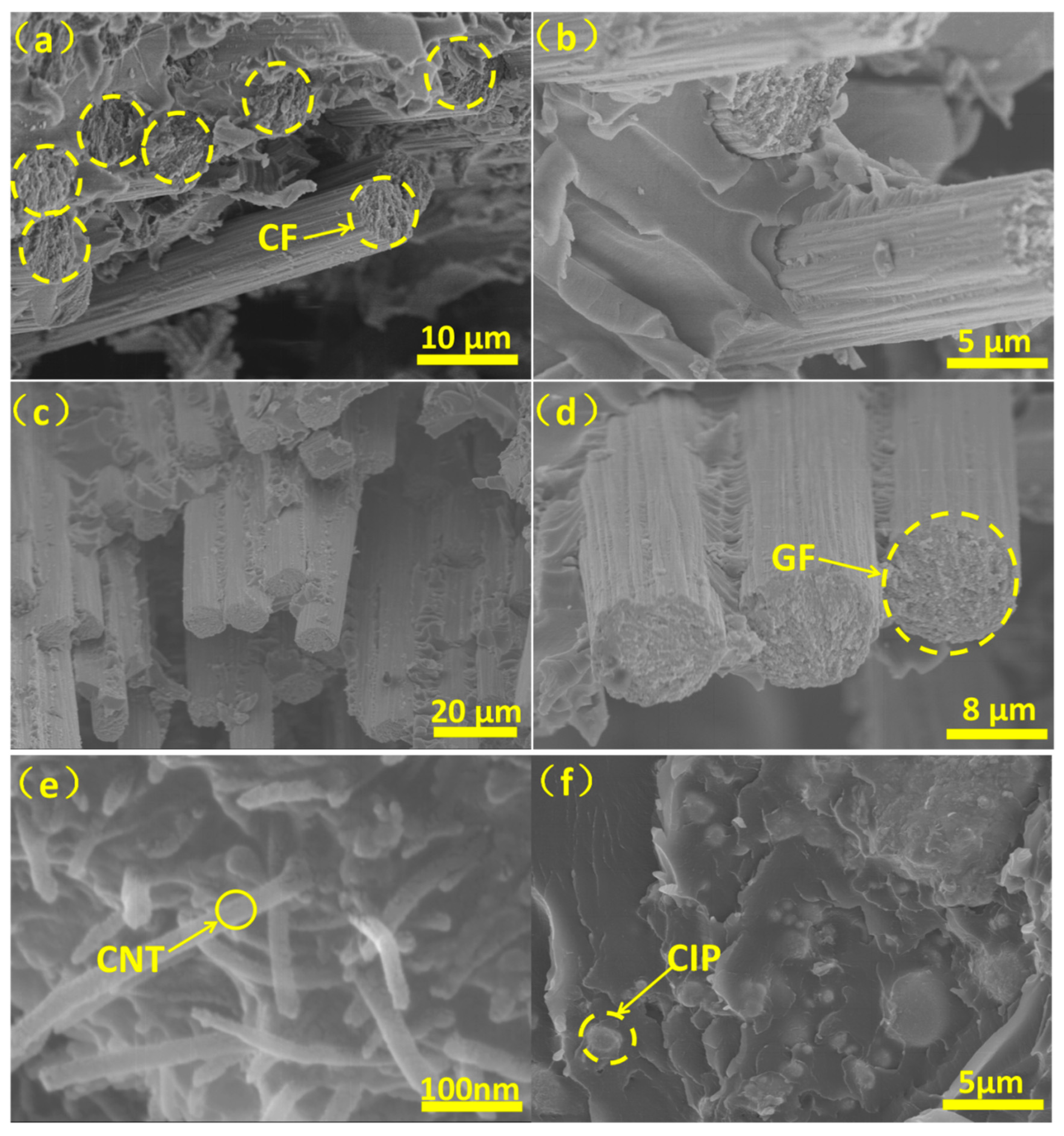
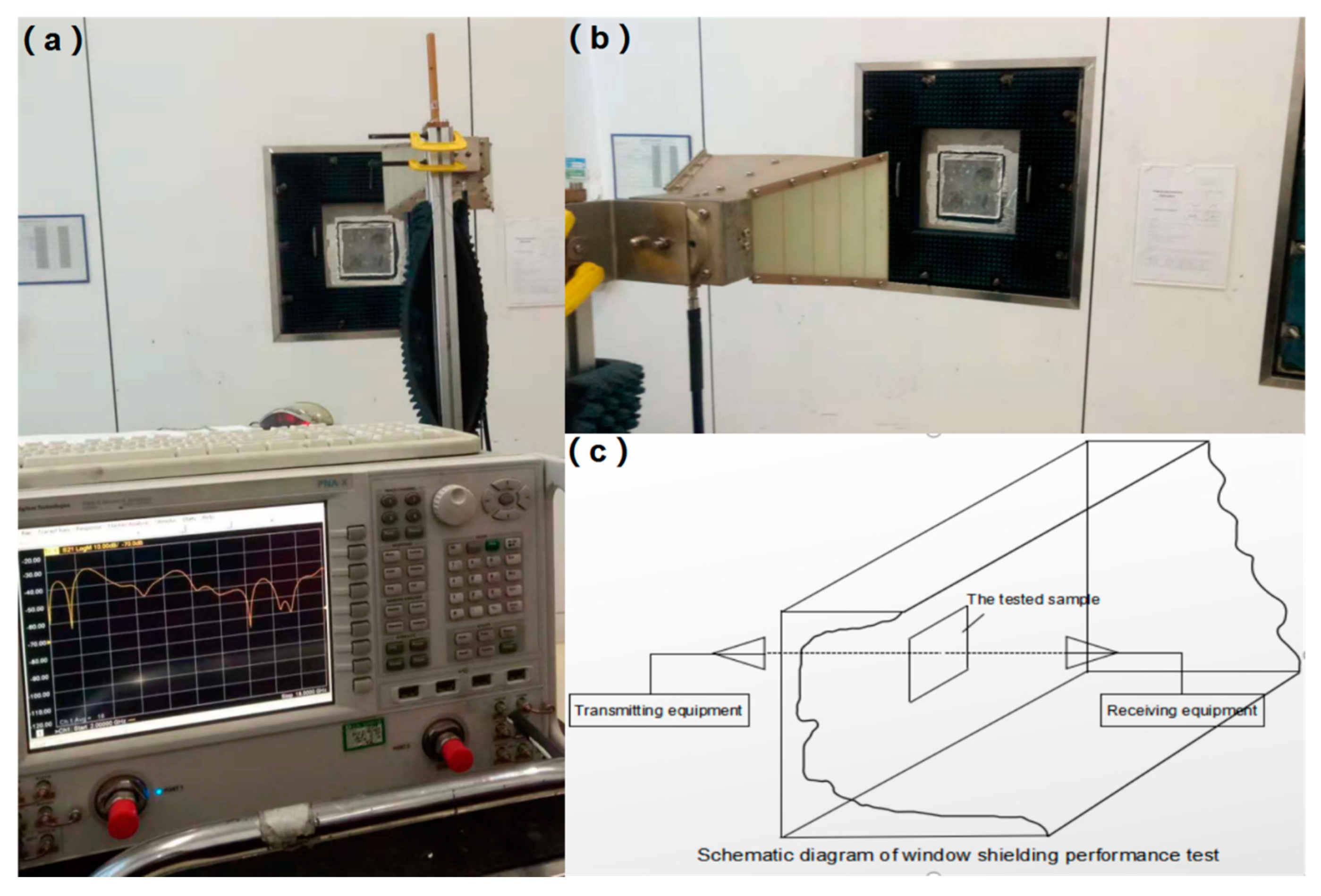
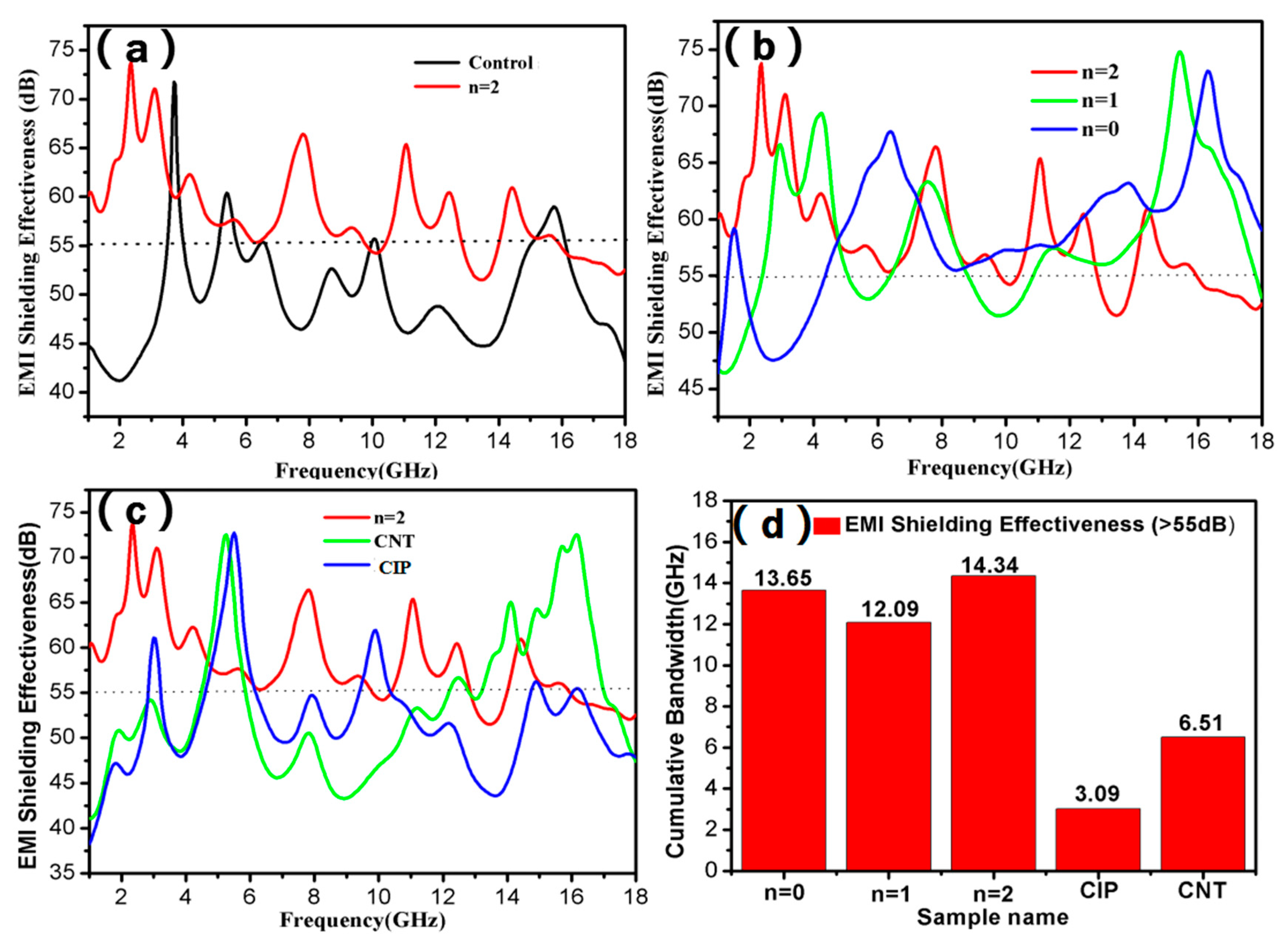

| Fiber (Brand) | Method of Knitting | 0° Tensile Strength (MPa) | Fiber Areal Weight (g/m2) | Thickness (mm) | Resin Volume Content (%) |
|---|---|---|---|---|---|
| CF(WP3021) | 2/2 twill | 670 | 198 | 0.25 | 40 |
| GF(218#) | 2/2 twill | 526 | 220 | 0.29 | 35 ± 5 |
© 2020 by the authors. Licensee MDPI, Basel, Switzerland. This article is an open access article distributed under the terms and conditions of the Creative Commons Attribution (CC BY) license (http://creativecommons.org/licenses/by/4.0/).
Share and Cite
Zhang, H.; Guo, Y.; Zhang, X.; Wang, X.; Wang, H.; Shi, C.; He, F. Enhanced Shielding Performance of Layered Carbon Fiber Composites Filled with Carbonyl Iron and Carbon Nanotubes in the Koch Curve Fractal Method. Molecules 2020, 25, 969. https://doi.org/10.3390/molecules25040969
Zhang H, Guo Y, Zhang X, Wang X, Wang H, Shi C, He F. Enhanced Shielding Performance of Layered Carbon Fiber Composites Filled with Carbonyl Iron and Carbon Nanotubes in the Koch Curve Fractal Method. Molecules. 2020; 25(4):969. https://doi.org/10.3390/molecules25040969
Chicago/Turabian StyleZhang, Hetong, Yue Guo, Xiang Zhang, Xinqian Wang, Hang Wang, Chunsheng Shi, and Fang He. 2020. "Enhanced Shielding Performance of Layered Carbon Fiber Composites Filled with Carbonyl Iron and Carbon Nanotubes in the Koch Curve Fractal Method" Molecules 25, no. 4: 969. https://doi.org/10.3390/molecules25040969
APA StyleZhang, H., Guo, Y., Zhang, X., Wang, X., Wang, H., Shi, C., & He, F. (2020). Enhanced Shielding Performance of Layered Carbon Fiber Composites Filled with Carbonyl Iron and Carbon Nanotubes in the Koch Curve Fractal Method. Molecules, 25(4), 969. https://doi.org/10.3390/molecules25040969




